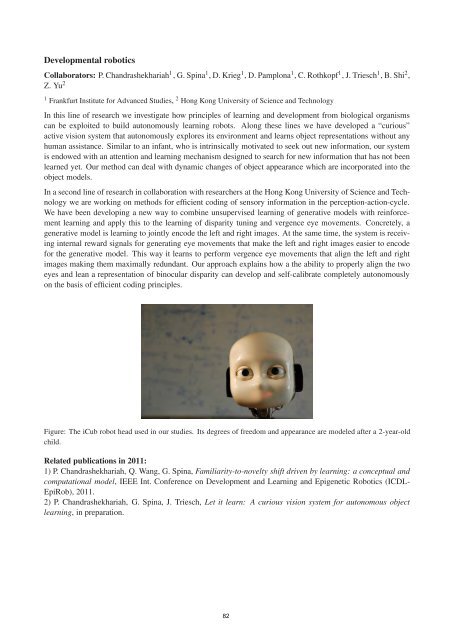FIAS Scientific Report 2011 - Frankfurt Institute for Advanced Studies ...
FIAS Scientific Report 2011 - Frankfurt Institute for Advanced Studies ...
FIAS Scientific Report 2011 - Frankfurt Institute for Advanced Studies ...
Create successful ePaper yourself
Turn your PDF publications into a flip-book with our unique Google optimized e-Paper software.
Developmental robotics<br />
Collaborators: P. Chandrashekhariah 1 , G. Spina 1 , D. Krieg 1 , D. Pamplona 1 , C. Rothkopf 1 , J. Triesch 1 , B. Shi 2 ,<br />
Z. Yu 2<br />
1 <strong>Frankfurt</strong> <strong>Institute</strong> <strong>for</strong> <strong>Advanced</strong> <strong>Studies</strong>, 2 Hong Kong University of Science and Technology<br />
In this line of research we investigate how principles of learning and development from biological organisms<br />
can be exploited to build autonomously learning robots. Along these lines we have developed a “curious”<br />
active vision system that autonomously explores its environment and learns object representations without any<br />
human assistance. Similar to an infant, who is intrinsically motivated to seek out new in<strong>for</strong>mation, our system<br />
is endowed with an attention and learning mechanism designed to search <strong>for</strong> new in<strong>for</strong>mation that has not been<br />
learned yet. Our method can deal with dynamic changes of object appearance which are incorporated into the<br />
object models.<br />
In a second line of research in collaboration with researchers at the Hong Kong University of Science and Technology<br />
we are working on methods <strong>for</strong> efficient coding of sensory in<strong>for</strong>mation in the perception-action-cycle.<br />
We have been developing a new way to combine unsupervised learning of generative models with rein<strong>for</strong>cement<br />
learning and apply this to the learning of disparity tuning and vergence eye movements. Concretely, a<br />
generative model is learning to jointly encode the left and right images. At the same time, the system is receiving<br />
internal reward signals <strong>for</strong> generating eye movements that make the left and right images easier to encode<br />
<strong>for</strong> the generative model. This way it learns to per<strong>for</strong>m vergence eye movements that align the left and right<br />
images making them maximally redundant. Our approach explains how a the ability to properly align the two<br />
eyes and lean a representation of binocular disparity can develop and self-calibrate completely autonomously<br />
on the basis of efficient coding principles.<br />
Figure: The iCub robot head used in our studies. Its degrees of freedom and appearance are modeled after a 2-year-old<br />
child.<br />
Related publications in <strong>2011</strong>:<br />
1) P. Chandrashekhariah, Q. Wang, G. Spina, Familiarity-to-novelty shift driven by learning: a conceptual and<br />
computational model, IEEE Int. Conference on Development and Learning and Epigenetic Robotics (ICDL-<br />
EpiRob), <strong>2011</strong>.<br />
2) P. Chandrashekhariah, G. Spina, J. Triesch, Let it learn: A curious vision system <strong>for</strong> autonomous object<br />
learning, in preparation.<br />
82
















